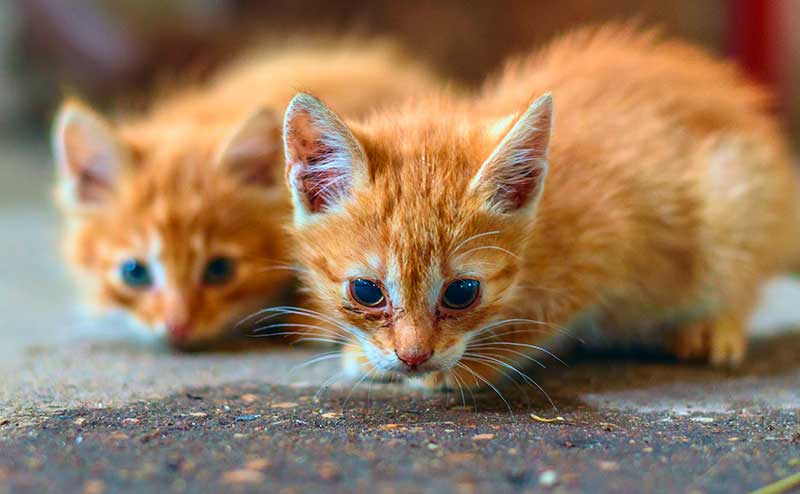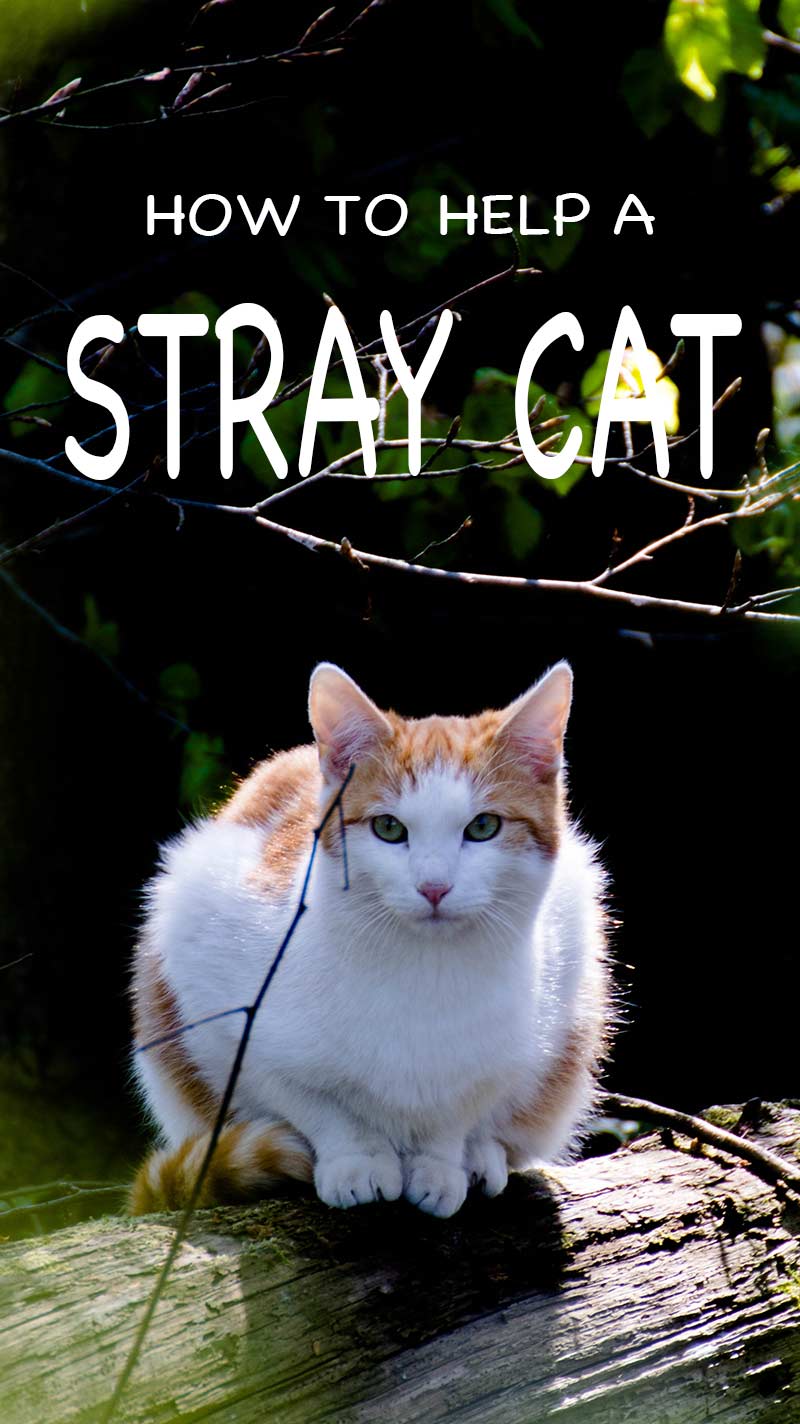There are lots of stray, ferrel and community cats around. When they come to your back door, what do you do? Cattlin Riffee of The Happy Cat has penned this piece to assist in making that decision.
Outside homeless cats eat a really wild diet of mice, rats, birds and human scraps. But if you want to help them survive the cold seasons then you can sometimes safely substitute their diet with pet cat kibble or wet food. But you need to be sure that the cat is definitely a feral feline and not someone’s outdoor cat or lost companion first. Today I share my top tips for helping a potentially stray kitty find it’s paws

Telling a Stray from an Outdoor Cat
Stray cats (cats who are lost or that were abandoned) are unfortunately quite common in most places. Cat protection groups find homes for thousands of stray cats each year. And those are only the ones that are reported! There are many more stray cats that remain on the streets.
Some strays may simply be lost domesticated cats, but cats who have been without human contact for some time are usually lean and may have rough fur coats or a generally unhealthy appearance.
It’s important to remember that even though a cat may have the appearance of a stray, a cat with a collar or identification tags is someone’s pet. Even if a cat does not have a collar on, it may be microchipped. Therefore, it’s important that you determine whether or not a cat that shows up on your stoop isn’t actually someone’s missing fur baby.
An exception might be made for small kittens, of which need much more attentive care than adults. Regardless of what you decide to do with a stray, you’ll need to be able to handle the cat. Some strays are afraid of humans, which could be a challenge.

What To Do When You Find A Cat
If you’ve found yourself with a stray cat, you should first check with people living close by to ensure that they haven’t lost a cat. Consider posting a picture and description of the cat to lost and found pages on various social media sites.
After all, our favorite felines are natural roamers when left to their own devices. It’s not unlike an indoor/outdoor pet cat to occasionally wander a little too far from home.
You might also considering taking the cat to your veterinarian to have it scanned for a microchip. If you’re unable to locate an owner for the cat and they do not have a collar or microchip, then you have a few options:
- Keep the cat. This will require that you take the cat for proper veterinary care as well as the necessary items for maintaining a healthy cat.
- Trap-Neuter-Return. This will ensure that the cat cannot contribute to the ever-expanding stray and feral cat population.
- Find it a home. You may have better luck rehoming the cat if you take it for vaccines, deworming, flea treatment, and/or spaying or neutering.
- Shelters. This is a better option than leaving the cat on its own, but it’s not ideal.
Animal shelters are often very overwhelmed with kittens. Those that have been dumped because people did not want to deal with them. So it’s important that you make every attempt to rehome the cat before surrendering it to a shelter.
Should You Feed Stray Cats?
Feeding stray cats is a subject of controversy. Some people say not to feed strays because they will come back to where they were fed. Possibly attracting other strays in the process, thereby creating a nuisance in the neighborhood.
Unless stray cats are specifically causing a problem in your community, there is nothing wrong with feeding them. However, feeding a stray is only the first step in improving the cat’s life as well as its chances of survival.
How would you like to be lost and scavenging for food? I imagine that you’d appreciate someone giving you something to eat.

A Really Wild Diet
When their diet isn’t being regulated by humans, cats are predators that hunt for mice, birds, fish, lizards, insects, rabbits, squirrels, and any other small animals that they can find. That doesn’t mean that you have to feed them “off the hoof,” so to speak.
What To Feed Stray Cats?
Actually, feeding strays regular cat food or canned tuna prevents them from killing too many of the local small animal population that we mentioned previously.
You can start feeding a stray a little bit of cat chow or canned food and plenty of fresh water. Stray kittens who are old enough to be weaned can have small amounts of kitten chow or canned food as well as fresh water.
Free Updates For Cat Lovers!
Our cat care articles, tips and fun facts, delivered to your inbox

Choose a brand that is high in fat and protein but low in carbohydrates. Their wild diet will be only meat based, and you want this transition to be as smooth as possible. If the cat appears to be under a year old a kitten specific food would be a good idea.
How Much Food Should I Give?
Do not give a full portion straight away, instead give just a spoonful morning and evening the first day. Up this by a single teaspoon each day, to allow the cat’s digestive system to get used to the change. Increase slowly over time until you reach the manufacturers guideline amount.
Indoor or Outdoor Feeding?
Stray cat wants to come inside? If you’re like me, then you’ll have a hard time turning away from an adorable face and hungry meows. The struggle is especially real if you’ve been unable to find the cat’s owner…assuming they were owned by one person in the first place.
Even if you have the means of keeping a stray, there are a few things to consider before bringing the cat or kitten into your home.
First of all, a stray cat most likely has fleas, ticks, and other creepy crawlies. Secondly, they may be overdue for worming medication and vaccinations.
Furthermore, if the stray is a tom cat, then you’ll want to have him neutered before bringing him into the house or letting him continue to roam your property. And if the stray hasn’t been kept indoors for some time, getting him or her adjusted to “pet life” may be harder than you think. Litter box training, scratching and chewing will be on the cards. Especially if the cat has been on his own for a long while.
Will Feeding Stray Cats Tame Them?
Like any animal that isn’t used to human contact, a stray cat will require time and patience before they warm up to you…IF they warm up to you. Some cats will eventually come around after you’ve been feeding them for a while. This may be the case for strays who were previously pets.
If a stray seems apprehensive of you but isn’t acting aggressive, then taming it might involve continuing to feed it while increasing the amount of time that you spend with the cat.
So for instance, you could sit near the cat while it eats. Eventually, the cat may become curious and approach you once they’re done chowing down. If the cat reacts in this way, then you might attempt to pet the cat.
It may help if you attempt this while feeding the cat in a somewhat enclosed area, such as an open garage or on your front porch.
It’s also important to note that as soon as the cat shows signs of fear, retreat to where you were when the cat was last comfortable with you. Then repeat the process until the cat accepts your presence and touch.
Unfortunately, some cats have been away from humans for so long that they cannot be tamed no matter how much time you spend near them or approach and retreat, as described above.
My neighbors took in a cat not knowing that she was pregnant. She had her kittens in my horse barn, so we were able to handle them fairly often. But not without getting spit on or batted at pretty frequently. Even after consistent handling, only one of the five kittens eventually became friendly toward people.
What to feed a stray cat or kitten
Feeding a stray kitten or cat may help to prevent them from hunting local wildlife. But strays often need more healthcare than a supplemented diet. You’ll also need to be confident they aren’t a lost pet or just a rangey looking outdoor kitty before you start to care for them.

